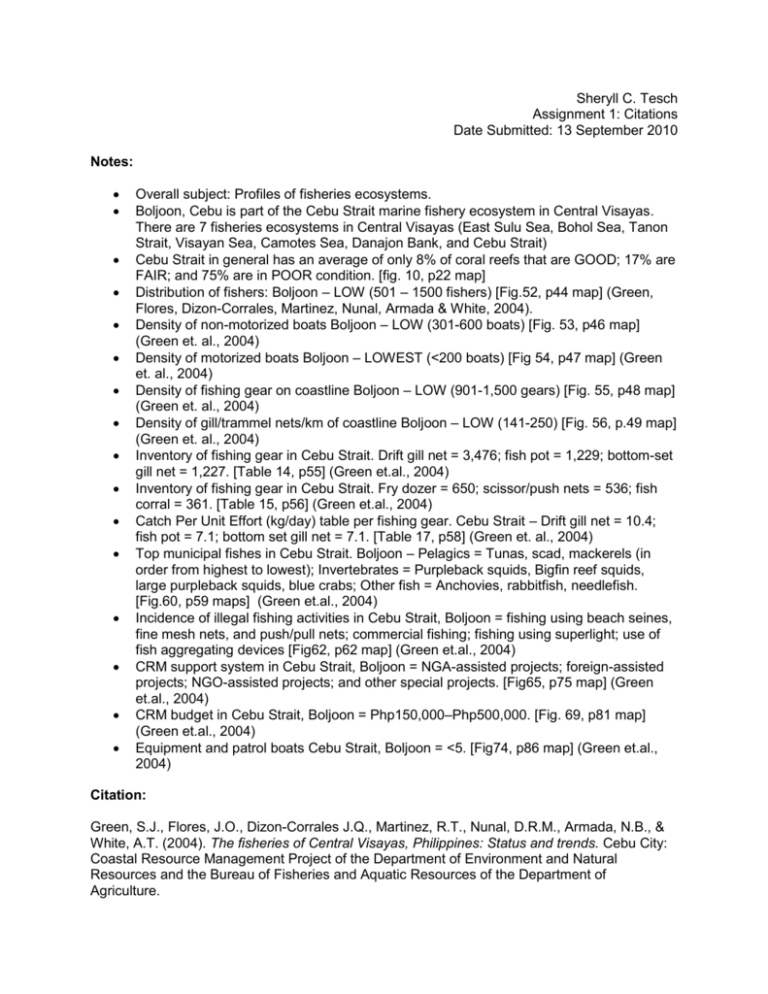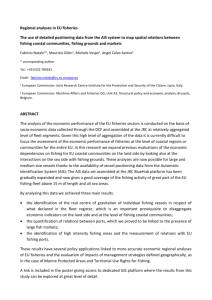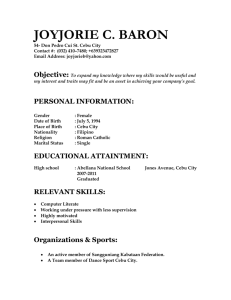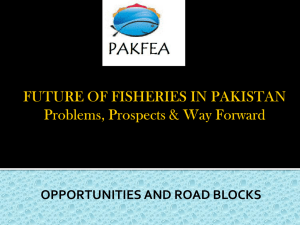Sheryll C. Tesch Assignment 1: Citations Date Submitted: 13
advertisement

Sheryll C. Tesch Assignment 1: Citations Date Submitted: 13 September 2010 Notes: Overall subject: Profiles of fisheries ecosystems. Boljoon, Cebu is part of the Cebu Strait marine fishery ecosystem in Central Visayas. There are 7 fisheries ecosystems in Central Visayas (East Sulu Sea, Bohol Sea, Tanon Strait, Visayan Sea, Camotes Sea, Danajon Bank, and Cebu Strait) Cebu Strait in general has an average of only 8% of coral reefs that are GOOD; 17% are FAIR; and 75% are in POOR condition. [fig. 10, p22 map] Distribution of fishers: Boljoon – LOW (501 – 1500 fishers) [Fig.52, p44 map] (Green, Flores, Dizon-Corrales, Martinez, Nunal, Armada & White, 2004). Density of non-motorized boats Boljoon – LOW (301-600 boats) [Fig. 53, p46 map] (Green et. al., 2004) Density of motorized boats Boljoon – LOWEST (<200 boats) [Fig 54, p47 map] (Green et. al., 2004) Density of fishing gear on coastline Boljoon – LOW (901-1,500 gears) [Fig. 55, p48 map] (Green et. al., 2004) Density of gill/trammel nets/km of coastline Boljoon – LOW (141-250) [Fig. 56, p.49 map] (Green et. al., 2004) Inventory of fishing gear in Cebu Strait. Drift gill net = 3,476; fish pot = 1,229; bottom-set gill net = 1,227. [Table 14, p55] (Green et.al., 2004) Inventory of fishing gear in Cebu Strait. Fry dozer = 650; scissor/push nets = 536; fish corral = 361. [Table 15, p56] (Green et.al., 2004) Catch Per Unit Effort (kg/day) table per fishing gear. Cebu Strait – Drift gill net = 10.4; fish pot = 7.1; bottom set gill net = 7.1. [Table 17, p58] (Green et. al., 2004) Top municipal fishes in Cebu Strait. Boljoon – Pelagics = Tunas, scad, mackerels (in order from highest to lowest); Invertebrates = Purpleback squids, Bigfin reef squids, large purpleback squids, blue crabs; Other fish = Anchovies, rabbitfish, needlefish. [Fig.60, p59 maps] (Green et.al., 2004) Incidence of illegal fishing activities in Cebu Strait, Boljoon = fishing using beach seines, fine mesh nets, and push/pull nets; commercial fishing; fishing using superlight; use of fish aggregating devices [Fig62, p62 map] (Green et.al., 2004) CRM support system in Cebu Strait, Boljoon = NGA-assisted projects; foreign-assisted projects; NGO-assisted projects; and other special projects. [Fig65, p75 map] (Green et.al., 2004) CRM budget in Cebu Strait, Boljoon = Php150,000–Php500,000. [Fig. 69, p81 map] (Green et.al., 2004) Equipment and patrol boats Cebu Strait, Boljoon = <5. [Fig74, p86 map] (Green et.al., 2004) Citation: Green, S.J., Flores, J.O., Dizon-Corrales J.Q., Martinez, R.T., Nunal, D.R.M., Armada, N.B., & White, A.T. (2004). The fisheries of Central Visayas, Philippines: Status and trends. Cebu City: Coastal Resource Management Project of the Department of Environment and Natural Resources and the Bureau of Fisheries and Aquatic Resources of the Department of Agriculture. Notes: Overall subject: Major aspects of coastal resource management (CRM), factors affecting the coastal environment and fisheries, and the role of local governments in CRM. Declining fisheries productivity because of loss of habitats and over-harvesting; and destructive fishing practices as well as conversion of habitats have degraded the Philippine coasts [p5] (Department of Environment and Natural Resources (DENR), Bureau of Fisheries and Aquatic Resources of the Department of Agriculture (BFARDA), & Department of the Interior and Local Government (DILG), 2001). Small-scale fishers are dependant on fishing as a livelihood and they fish in productive fishing areas that are ‘open-access’ meaning that there is basically a lack of national and local regulation to properly manage the fisheries resources. [p8] (DENR et. al, 2001) Conflicting human use of natural resources for purposes of habitation, tourism, industry, fishing boat landings, dumping of wastes, construction, etc. Illegal activities on the coast: habitat destruction; banned species harvesting; conversion of natural habitats into human use areas; ignoring regulations on set-backs on the foreshore; commercial fishing within municipal waters; illegal fishing methods such as modified beach seines, cyanide fishing, superlights and dynamite fishing, among others. Other developments affecting coastal area: developments in agriculture, construction on the foreshore, land fills and conversions, quarrying and mining, tourism. [p13] Decreasing value of reefs “Net present value of blast fishing to individuals and associated losses to society per square kilometre of reef (in thousand US$, over 25 years, 10 percent discount rate)” (Cesar 1996) [bar graph on p14] Decrease in fish yields “Fish yield decline and loss on a destroyed and recovering coral reef over 10 years” (Alcala and Gomez, 1979; White and Cruz Trinidad, 1998) [bar graph on p14] Need for biodiversity conservation due to rich marine resources Key issues on the coasts that need to be addressed: 1. Increased fishing effort (municipal and commercial) 2. Slow coastal town economic development 3. Destructive and illegal fishing methods 4. Commercial fishing in municipal waters 5. Open access fisheries 6. Coastal habitat degradation 7. CRM is weakly implemented on both local and national levels Citation: Department of Environment and Natural Resources, Bureau of Fisheries and Aquatic Resources of the Department of Agriculture, & Department of the Interior and Local Government. (2001). Philippine Coastal Management Guidebook No. 1: Coastal Management Orientation and Overview. Cebu City: Coastal Resource Management Project of the Department of Environment and Natural Resources and the Bureau of Fisheries and Aquatic Resources of the Department of Agriculture. Notes: Overall Subject: Scaling up management and protected area coverage and threats to MPA network/municipal cluster management. Scaling up management from community level to one of an MPA network needs to be done carefully so that the commitment of the community to the MPA goals is not threatened and the capacity of the higher institution is not overwhelmed. (Schleit, 2010) “Institutional coordination, management capacity and cross-scale stakeholder involvement emerge as necessary conditions. Progress by the Management Council in meeting these conditions varies and there are still barriers to overcome. This case study reveals that successful management at the single MPA level can facilitate scaling up.” (Schleit, 2010) “Widespread coastal and marine resource depletion is increasing the need to protect marine resources and ecosystems at larger spatial scales than single MPAs” (Lowry et al., 2009). Christie et al., (2009) define a socio-ecological MPA network as: “A collection of individual marine protected areas, management institutions and constituencies operating cooperatively and synergistically, at various spatial scales, and with a range of protection levels, in order to fulfill ecological, social, economic and governance aims more effectively and comprehensively than individual sites could alone.” Instead, the bottom-up community based process must be combined with cross-level linkages as “neither purely local level management nor purely higher level management works well by itself” (Berkes, 2002). Barrier removal = The Philippine Constitution states that “local government units may group themselves, consolidate or coordinate their efforts, services, and resources for purposes commonly beneficial to them”. The Constitution provides the legal possibility for inter-municipal institutional networks. The Local Government Code of 1991, section 35, also “specifically states that LGUs may enter into joint ventures and such other cooperative arrangement with people's organization (PO) and non-governmental organizations (NGOs) to engage in the delivery of certain basic services” (Pomeroy et al., 2010). The learning process framework established by Uphoff et al. (1998) include: (1) creative leadership, (2) effective local organizations and people's participation, (3) adaptive systems for management, (4) appropriate technologies and training that shares needed knowledge, (5) systems that use information as a management tool, (5) linkages with key local, regional national and international actors and (6) political support. Themes of scaling up management and protected area coverage (Schleit, 2010): 1. Institutional coordination – previous trust and success; continued support from external agency. 2. Management capacity – technical knowledge of MPA networking; regular patrolling; ecological knowledge; incentives for regular participation. 3. Cross-scale stakeholder involvement – stakeholders aware of MPA networking activities; strong participation from community groups. Citation: Schleit, K.E. (2010). Institutional conditions and barriers in marine protected area networking: A case study from the Central Philippines. Seattle: University of Washington.







